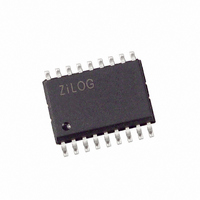Z8PE003SZ010EG Zilog, Z8PE003SZ010EG Datasheet - Page 25

Z8PE003SZ010EG
Manufacturer Part Number
Z8PE003SZ010EG
Description
IC MICROCONTROLLER 1K 18-SOIC
Manufacturer
Zilog
Series
Z8® Plusr
Specifications of Z8PE003SZ010EG
Core Processor
Z8
Core Size
8-Bit
Speed
10MHz
Peripherals
Brown-out Detect/Reset, POR, PWM, WDT
Number Of I /o
14
Program Memory Size
1KB (1K x 8)
Program Memory Type
OTP
Ram Size
64 x 8
Voltage - Supply (vcc/vdd)
4.5 V ~ 5.5 V
Oscillator Type
Internal
Operating Temperature
-40°C ~ 105°C
Package / Case
18-SOIC (7.5mm Width)
Lead Free Status / RoHS Status
Lead free / RoHS Compliant
Eeprom Size
-
Data Converters
-
Connectivity
-
Other names
269-4294
Z8PE003SZ010EG
Z8PE003SZ010EG
ZiLOG
OSCILLATOR OPERATION
The Z8Plus MCU uses a Pierce oscillator with an internal
feedback resistor (Figure 14). The advantages of this circuit
are low-cost, large output signal, low-power level in the
crystal, stability with respect to
low impedances (not disturbed by stray effects).
One drawback to the Pierce oscillator is the requirement for
high gain in the amplifier to compensate for feedback path
losses. The oscillator amplifies its own noise at start-up until
it settles at the frequency that satisfies the gain/phase re-
quirements.
amplifier, and
The total phase shift around the loop is forced to
grees).
plifier/inverter provides a 180-degree phase shift, and the
feedback element is forced to provide the other 180-degree
phase shift.
R1
the amplifier. The purpose of this feedback is to bias the am-
plifier in its linear region and provide the start-up transition.
Capacitor
tance, provides a small phase shift. It also provides some
attenuation of overtones.
Capacitor
vides an additional phase shift.
Start-up time may be affected if
matically in size. As
DS007500-Z8X0399
is a resistive component placed from output to input of
XTAL1
V
IN
C
C2
must be in phase with itself; therefore, the am-
Figure 14. Pierce Oscillator with
1
A x B = 1
, combined with the crystal resistance, pro-
, combined with the amplifier output resis-
B = VI/VO
V
Internal Feedback Circuit
1
A
C
1
Z8Plus
C
R
; where
I
1
is the gain of the feedback element.
and
V
C
0
A = VO/VI
2
C
increase, the start-up time
XTAL2
V
1
CC
C
and
2
and temperature, and
C
V
2
SS
are increased dra-
is the gain of the
0
P R E L I M I N A R Y
(360 de-
increases until the oscillator reaches a point where it ceases
to operate.
For fast and reliable oscillator start-up over the manufac-
turing process range, the load capacitors should be sized as
low as possible without resulting in overtone operation.
Layout
Traces connecting crystal, caps, and the Z8Plus oscillator
pins should be as short and wide as possible to reduce par-
asitic inductance and resistance. The components (caps, the
crystal, and resistors) should be placed as close as possible
to the oscillator pins of the Z8Plus.
The traces from the oscillator pins of the integrated circuit
(IC) and the ground side of the lead caps should be guarded
from all other traces (clock,
system ground) to reduce cross talk and noise injection.
Guarding is usually accomplished by keeping other traces
and system ground trace planes away from the oscillator cir-
cuit, and by placing a Z8Plus device
the traces/components. The ground side of the oscillator
lead caps should be connected to a single trace to the Z8Plus
device
system-ground trace or components except at the Z8Plus
device
tem ground noise injection into the oscillator (Figure 15).
Indications of an Unreliable Design
There are two major indicators that are used in working de-
signs to determine their reliability over full lot and temper-
ature variations. They are:
Start-Up Time.
widely from unit to unit, there is probably a gain problem.
To fix the problem, the
tion. The amplifier gain is either not adequate at frequency,
or the crystal
Output Level.
swing from ground to
amplifier. As the oscillator starts up, the signal amplitude
grows until clipping occurs. At that point, the loop gain is
effectively reduced to unity, and constant oscillation is
achieved. A signal of less than 2.5 volts peak-to-peak is an
indication that low gain can be a problem. Either
should be made smaller, or a low-resistance crystal should
be used.
V
V
SS
SS
(GND)
pin. The objective is to prevent differential sys-
R
’s are too large.
The signal at the amplifier output should
If start-up time is excessive, or varies
pin. It should not be shared with any other
V
C
CC
1
and
to indicate adequate gain in the
Z8Plus OTP Microcontroller
V
C
CC
2
, address/data lines, and
capacitors require reduc-
V
SS
ground ring around
Z8PE003
C
1
or
C
25
2
















